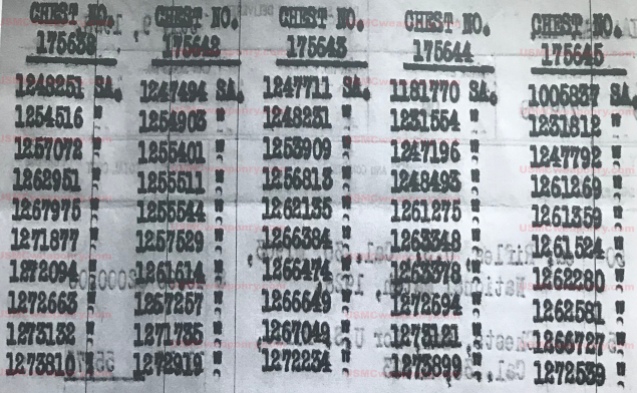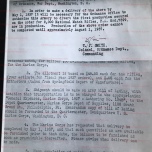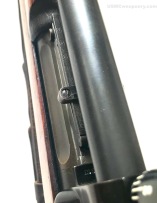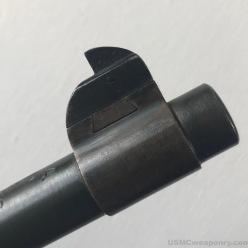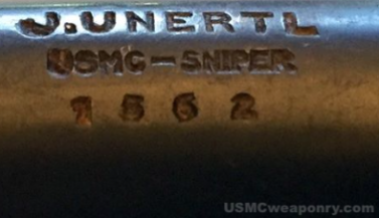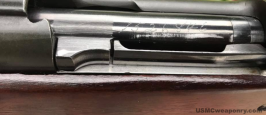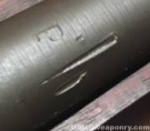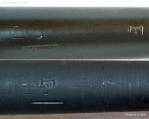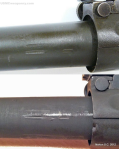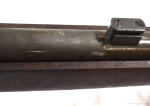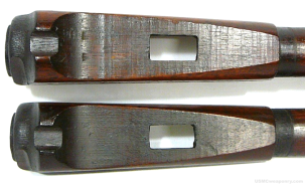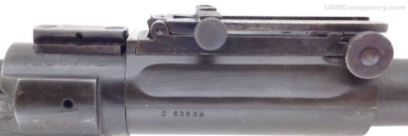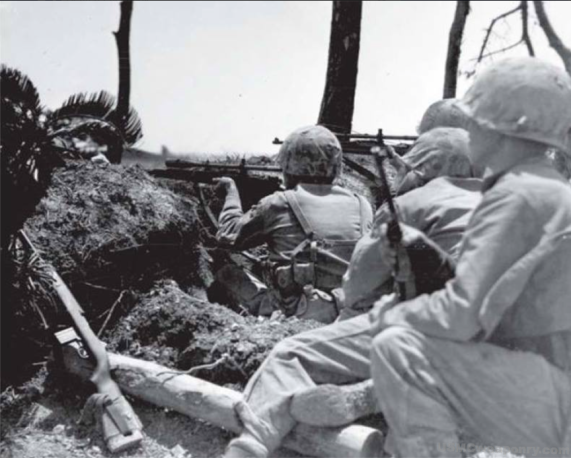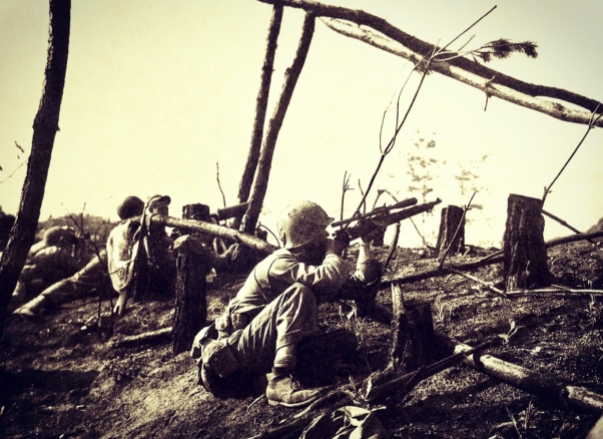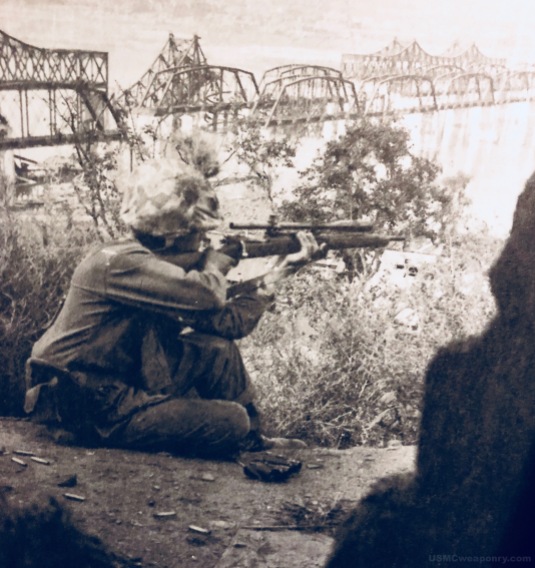 The most iconic sniper rifle of the Second World War, the USMC M1903A1 8x Unertl equipped sniper rifle was the backbone of Marine snipers in WWII and Korea.
The most iconic sniper rifle of the Second World War, the USMC M1903A1 8x Unertl equipped sniper rifle was the backbone of Marine snipers in WWII and Korea.
Born of the Marine Corps’ elite National Match rifle teams, the story of the National Match M1903 and M1903A1 Unertl sniper rifle are one and the same as it was from the former that the latter were selected. The Unertl sniper rifle was to be a tenuous program, but one which nonetheless produced the most capable and deadly sniper rifle of WWII. To properly tell the Unertl sniper rifle’s story, one must go back to the golden era of military team shooting: the years in between the world wars. Camp Perry in Port Clinton, Ohio is the mecca of American high power rifle competition, and has been host to the vast majority of the National Matches since their inception in 1907. To this day the very the best military and civilian shooters in the nation (and world for that matter) gather for several weeks in the summer heat to compete in the most prestigious events the nation has to offer, and it was from an intense desire to take home Camp Perry’s National Match trophies where this story begins.
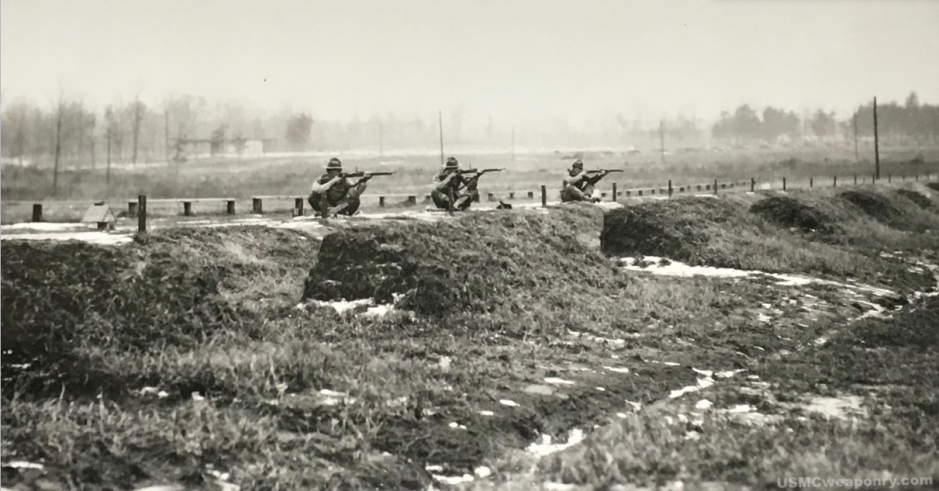 Marine team shooters on the range practicing the 200 yard rapid fire portion of the National Trophy course of fire, which is executed from the sitting position (photo: NARA).
Marine team shooters on the range practicing the 200 yard rapid fire portion of the National Trophy course of fire, which is executed from the sitting position (photo: NARA).


The biggest change to the National Match M1903 came in 1929, with the advent of the pistol-gripped “C” stock. With bright, unfinished bolts that were serialized to the rifle, National Match variants of the M1903 stood out from regular service rifle models.
The American Expeditionary Force had performed well during WWI, particularly when it came to devastatingly accurate fire. Seeking to capitalize on this newfound respect for the American rifleman, the competition between the army and Marine teams would reach a fever pitch as to who could claim to have the country’s most elite marksmen. Public interest in competitive shooting was rising to new heights, and the performance and new availability of the standard issue rifle to civilians encouraged many throughout the nation to participate in matches run by the National Rifle Association or Department of Civilian Marksmanship (now the Civilian Marksmanship Program), the two sanctioning bodies for American high power competition. The military teams were well versed in their main tool for the job, as the M1903 Springfield had already proven to be an excellent rifle for match purposes. The specially tuned National Match variants were truly works of art, and the craftsmanship seemed to get better with each passing year. Sporting buttery smooth actions with nickel-steel bolts, match grade triggers, extra coarse buttplates to better grip the jacket of the competition shooter, and most importantly “star gauged” barrels that were remarkably accurate, the National Match M1903 was a thing of beauty in terms of aesthetics and what it could do on the range.
The Marine rifle team on the range, practicing the prone and offhand positions of the National Trophy regimen (photos: NARA).
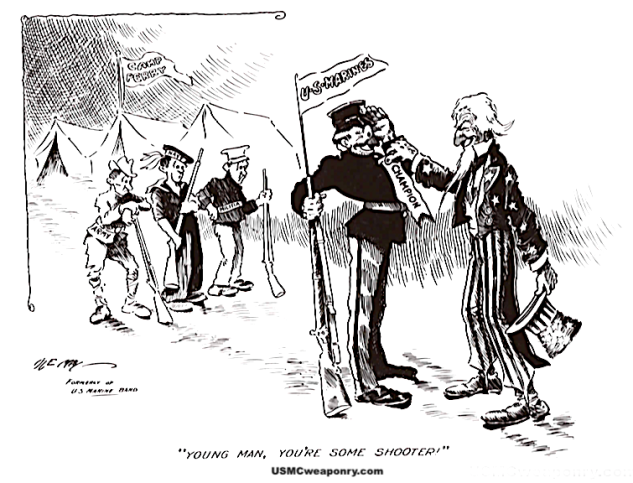
In order to stay at the peak of performance, the Marine Corps would order new shipments of National Match M1903’s from Springfield Armory nearly every year, the quantity ranging from 100 to 175 rifles, as well as a host of other small parts and rear sight slides that were offset to allow precise zeroing of a rifle. While some of the receivers and other parts inconsequential to performance were of older manufacture, all specially accurized or better functioning items were always fresh from production.
Example of a shipment of National Match M1903s from Springfield Armory to the Marine Corps Rifle Team in 1928 (documents: NARA).
Documents showing the annual orders of National Match M1903A1s for the Marine Corps (documents: NARA).
A significant change to the M1903 in regards to ergonomics and performance would take place in 1929, just before the National Matches at Camp Perry. Addressing previous criticisms of the original design “straight stock,” Springfield Armory’s new “C-stock” incorporated a pistol grip and a higher butt stock into the design, allowing for a much more shooter friendly cheek position. The rifle itself would remain the same, but the change in stock design would see C-stock equipped rifles designated on paper as the M1903A1, an army label only occasionally used by the Marines. The advent of the C-stock would be welcomed by the Marine Corps rifle team, and all National Match rifles would come in the new stock, though some older team shooters chose to retain their original straight stocks due to their familiarity with the older style.
Marine teams throughout the interwar period. While most shooters embraced the new C-stock, one Marine shooter in particular can be seen in several photos with an older style straight stocked rifle instead (photos: NARA).
“DOPE” tags on the side of Marine team shooters’ rifles (photos: USMC).
The Marine shooting teams would take accurizing their National Match rifles farther than the fine product they received from Springfield Armory, and their intricate tweaks have played a significant role in the identification of Unertl sniper rifles, especially those that are largely original. The most dramatic modification would be referred to as the “6 o’clock bed,” as the area surrounding the rear sight base of the rifle would be milled out to allow the barrel to only touch the stock at the 6 o’clock position of the front sight band. This very early attempt at free-floating a barrel would would leave the stock very thin around the rear sight base, and the similarity between stocks which have undergone this modification is remarkable. Both C-stocks and straight stocks have been found on Unertl snipers with this modification. Another stock modification would be in the milling out around the bolt handle area of the stock to ensure the bolt and stock would not touch, thus allowing the bolt to fully go into battery without impediment and give a smoother action. This modification has also been seen on regular USMC M1903’s, likely a trick learned from team shooters and armorers as they rotated back to regular billets in the Marine Corps.
Top left: Unertl sniper rifle 1459600’s milled out straight stock. Bottom left: Unertl sniper 1496440’s milled out straight stock. Right: the milled out portion of the stock around the rear sight base as shown with action in the stock (Steven Norton & Tim Plowman collections).
Examples of the bolt handle clearance modification (Steven Norton & Tim Plowman collections).
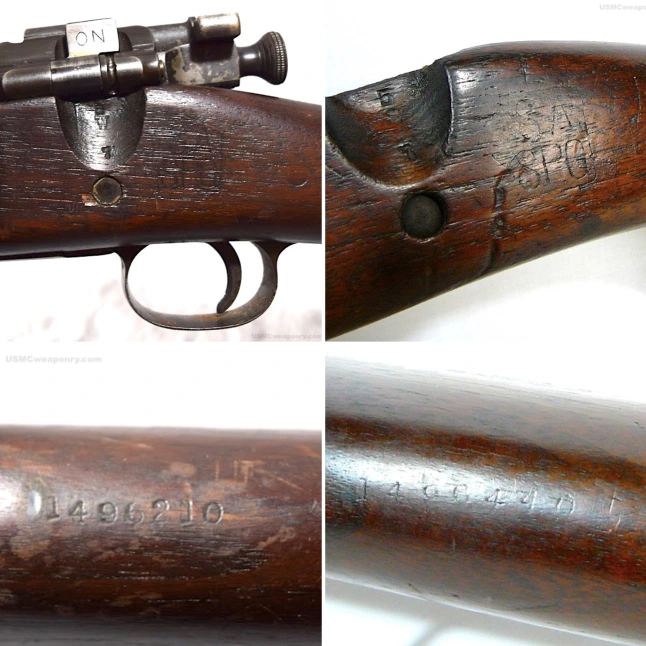
Left: C-stock serialized to USMC National Match rifle #1496210, which is fitted to Unertl sniper rifle #1496175. Right: Original, serialized C-stock on Unertl sniper rifle #1496440. Both: The SA/SPG cartouche denotes Springfield Armory manufacture with Stanley P. Gibbs serving as the chief inspector during that time period. The 7 that both rifles have in the magazine cutoff well indicates the year they would have left Springfield Armory, both being sent to the Marines in the 1937 shipment of National Match rifles (Andrew Stolinski & Tim Plowman collections).
Outside of the stock, the Marine rifle teams would employ a host of other modifications to the rifle itself. Front sights have been observed to have a variety of colors of paint on them, either to permanently blacken them or to better allow the sooty “sight-black” that was applied pre-match to adhere. Some sniper rifles have been observed with white paint on the front sight as well, presumably to minimize their visibility from inside the Unertl scope. A fairly universal modification for all USMC M1903s, the trigger guard would be staked to ensure the screws would not back out and lose the appropriate tension. As with the bolt handle clearance cut on the stock, it is almost assuredly a practice that began with the Marine teams and filtered into practice for regular unit Marine armorers.
Painted front sights and staked trigger guards are almost always observed on former Marine team rifles (Tim Plowman collection).
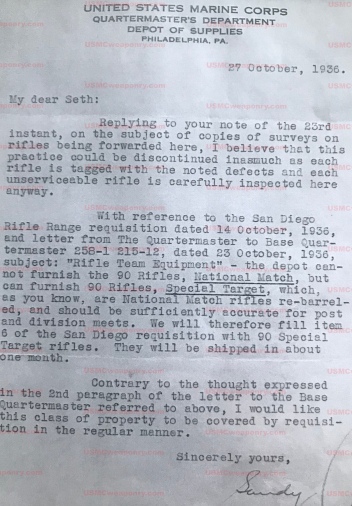
When National Match rifles would have their original star gauged barrels worn out, they would be sent to the overhaul facility in Philadelphia to have a new, standard Springfield Armory barrel installed. These rifles would be referred to as “special target” rifles, and given to unit level rifle teams, or held for divisional matches (document: NARA).
After the heights of the 1920s and 1930s, the following decade would spell the end of the National Match M1903A1. Springfield Armory’s new M1 Garand would now be produced in a National Match form, and production of the M1903A1 ceased. The rising likelihood of American involvement in the Second World War would also spark a renewed interest in the utilization of a sniper rifle. Initially, the Marine Corps decided to use their significant stock of deconstructed WWI sniper rifles of the Mann Niedner and Winchester variety. These rifles employed the Winchester A5 or Lyman 5A scope, and would be used early in the war by the elite Marine Raiders and the infantrymen of the 1st and 2nd Marine Divisions. The A5/5A scope was a product of WWI, and as such was already aging technology. The Marines realized this, and began an earnest search for a better optic in 1941. The work of John Unertl impressed the Marines, and they would eventually decide on his eight power USMC Sniper scope as their mainstay optic for the new war. Having sensed the impending need for a sniper rifle to mount the Unertl scope on, the Marine brass had collected all of the National Match and Special Target M1903s Corps-wide, holding them aside in case they decided to convert them to sniper rifles. The National Match and Special Target M1903s were not a shoe-in for conversion, as they had competition from the Winchester Model 70 bolt action sporting rifle. The Marine Corps had purchased nearly 400 Winchester Model 70s in 1941, and while they did perform quite well, it was decided that the National Match M1903 would be a superior sniper rifle for logistical purposes. Marine infantrymen and lower level armorers were already very familiar with the M1903, and the interchangeability and easy access to parts would allow for hasty repairs in the field.
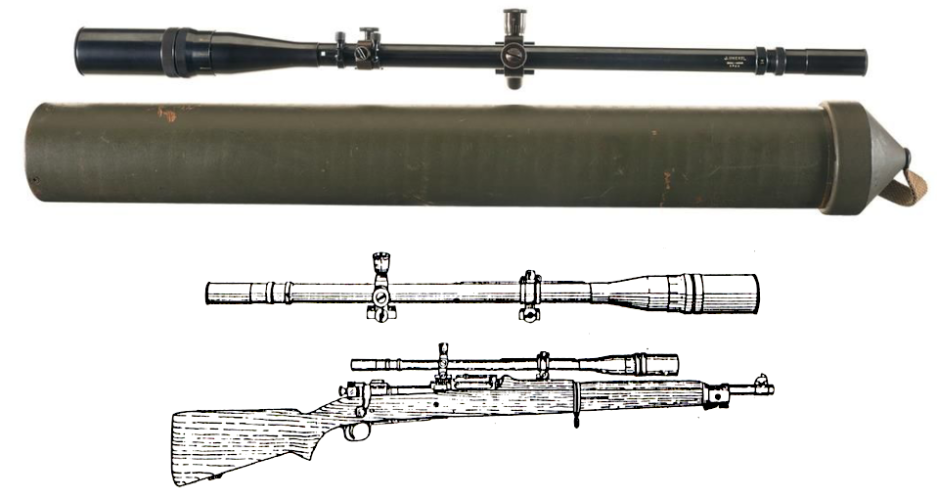
The Unertl 8x USMC Sniper scope was specifically marked and thus is easy to identify today. The external surface was blued, but parkerized examples have been found suggesting they were refinished while in service. Original reticles can be identified by the presence of a dot where the lines intersect, allowing the shooter a better focal point. The scope came with a micarta carrying case, which was not utilized operationally by the Marines.
Documents detailing the process of selecting the National Match and Special Target M1903’s as the platform for the Unertl 8x USMC Sniper scope (documents: NARA).
One noteworthy and necessary change that would take place as the National Match and Special Target rifles were in the early process of being converted to sniper rifles was the bluing of the nickel-steel National Match bolts. “In the white,” the glare from the finish-less bolts would not be suitable for military service. The bluing process however was only somewhat successful in reducing the shine, as the nickel-steel content of the bolts left them with a unique, watery finish that can appear as almost a dark purple color, which could range from black to not present at all in the right light. The bolt handles in particular were still quite shiny, and can be seen gleaming in the sun in period era photos. This allowed for many to believe that Unertl sniper rifles maintained their unfinished bolts before the discovery of documents detailing the bluing process were uncovered at the National Archives, and the ability to confirm examples of original Unertl sniper rifles existed. Close examination of existing rifles and period photos show the watery finish is indeed present. One of the better ways to notice this is by examining the extractors, which the bluing adhered to much more strongly. Sadly, the incorrect belief that the bolts were still in the white during sniper use led to some original examples having their blued bolts polished by subsequent owners, destroying the original finish applied by the USMC.
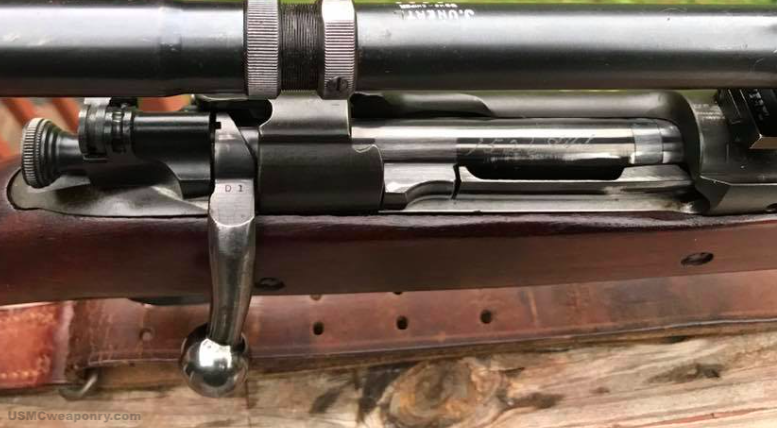
After going through the bluing process, the previously bright National Match bolts would vary from shiny to black depending on the light (Greg Carlson collection).
Beyond the the bluing modification, the NM bolts were also often hand polished in specific areas for a smoother action, existing Unertl sniper rifles with their original bolts typically have a buttery smooth action indicative of the level of care the rifle received during their time with the Marine rifle teams. As such, bolt attributes are an important factor that allow for an easier identification process when examining a potential Unertl sniper rifle.
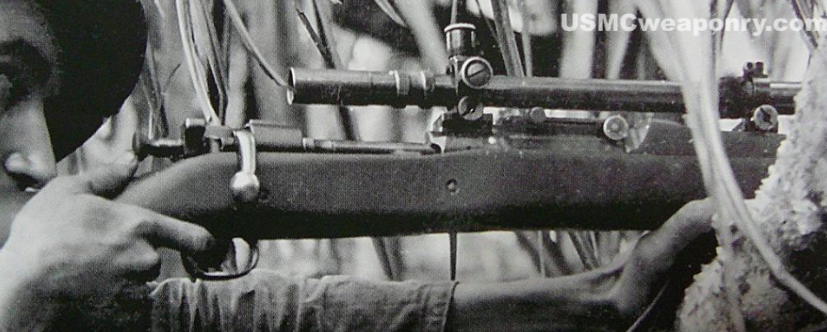
Example of blued bolt in M1903A1 Sniper rifle in WWII, the extractors in particular show the bluing in period era photos (photo: NARA). In black and white photos in particular, the bolt handle of the blued NM bolts can appear bright, when in fact they are not.
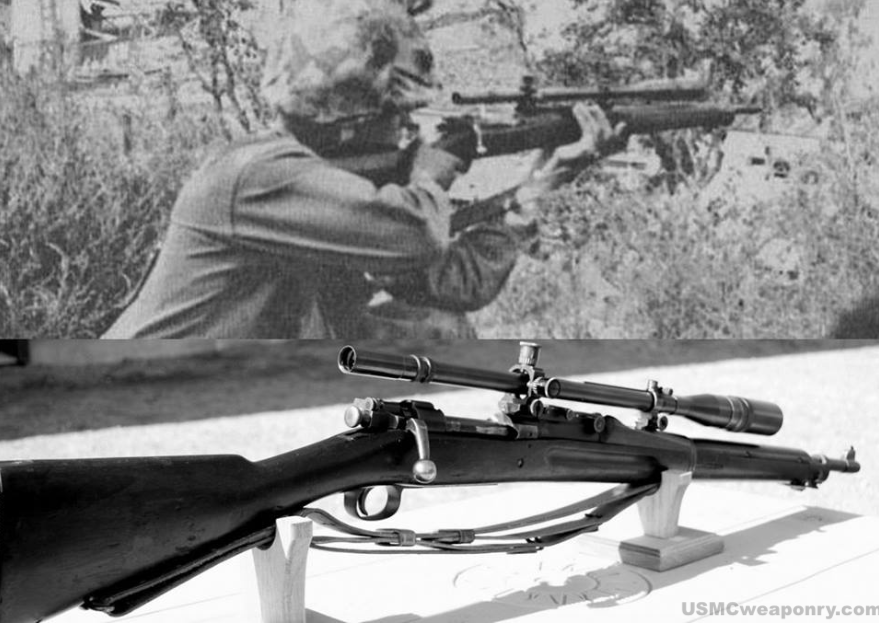
The order for the bright NM bolts to be blued, and examples of the unique watery finish that the bluing produced (document: NARA, photos & rifles: Steven Norton, Greg Carlson, Neil Duffy, Georg Oberaigner, & Tim Plowman collections).
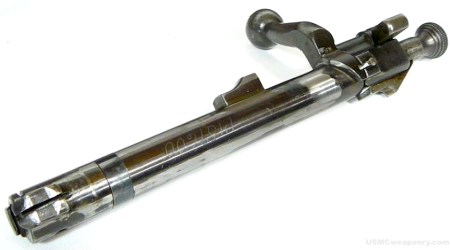
Another interesting modification would take place with the Marine rifle team precisely fitting each trigger housing to the receiver and stock. The various degrees of which this practice was necessary can be seen in examples that retain their original trigger housing and the various amount of milling that was required. Some trigger housings would be milled on the screw well and the magazine well, while others would only require one of these areas to be modified, showing the precise and individual nature of this modification. Not all Unertl sniper rifles have this modification however, as obviously some trigger housings were a good fit from the get-go, and the trigger housing was also a part that could easily be replaced in the field or during overhaul.
Examples of modified trigger housings that were milled for a more precise fit on Marine team rifles (Steven Norton & Tim Plowman collections).
Of the 1047 rifles set aside for the purpose of the Unertl sniper program, 574 were of the Special Target variety. As mentioned in the document previously, these were National Match rifles that had been refitted with new, standard issue Springfield Armory barrels after their original star gauged National Match barrels had become unserviceable. Most Special Target turned Unertl sniper rifles have been observed with 1938 dated barrels, though a few other years have also been observed. During the conversion process, no preference was given to rifles with star gauged barrels, instead the selection of which rifles to convert first was done practically: those that grouped the best were converted first. Most confirmed Unertl sniper rifles are in or around the 1,496,xxx and 1,526,xxx serial number ranges, which corresponds to the final two shipments of National Match rifles the USMC rifle teams received, in 1937 and 1939 respectively. It stands to reason that the newest National Match rifles that still had good condition, original star gauged barrels would be the most accurate, and that is why these two serial number ranges are by far the most dense with confirmed Unertl sniper rifles. However, the noteworthy amount of confirmed Unertl sniper rifles that were converted from the Special Target variety show that their newer, standard barrels were more than up to the task accuracy wise. The Special Target Unertl sniper rifles spread a wide range serial number wise, with some having receivers that were manufactured as far back as the 1920s and as late as the final shipment of National Match M1903s the Marines received. The Special Target barrels also bear the tell-tale “vise marks” near the rear sight base, associated with Marine armorer’s use of plumber’s wrench type equipment during barrel changing procedures. While vise marks on standard service rifles run the gambit on the pattern left behind, the ones which have been observed on Special Target M1903s have a strikingly similar pattern on the barrel. While this doesn’t mean too much in and of itself, it is an interesting coincidence nonetheless, logically indicative of the barrels having been changed on the same equipment, and likely in chunks.
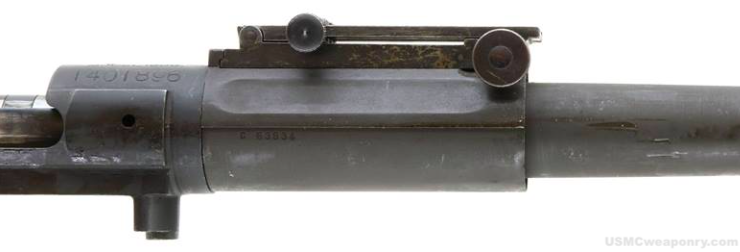
Similarities in the vise marks found on Unertl Sniper rifles with Special Target barrels (Steven Norton & Georg Oberaigner collections).
After the 1047 National Match and Special Target rifles were test fired to determine the most accurate of the bunch, the next step in the process was to drill and tap the receiver and barrel. While some minor variance is present, the locations that were drilled are nearly identical. On all original Unertl sniper rifles examined, the rear sight block butts up to the rear sight base to the point of nearly touching. Currently no photographs or mention is made of what type of vise was used during the mounting process, but it was affixed to the bottom of the receiver and barrel and allowed precise work, as the craftsmanship is exceptional. In order to drill and tap each rifle, the barreled receiver was removed from the stock and the rest of the parts of the rifle set aside. The Marine armorers knew the importance of reassembling these highly accurized rifles with exactly the same parts they came in with, since each had parts specifically fitted from their time with the rifle teams.
The location where the National Match and Special Target rifles were drilled and tapped during the sniper conversion process is very consistent in original examples. The star gauge markings on the barrel are generally near or under the area the front block would be mounted on National Match Unertl sniper rifles. An interesting example, Unertl sniper rifle #1401896 was reconverted back to a standard issue service rifle at some point. Juxtaposed with Unertl sniper rifle #1459600, the similar location of the drilling and tapping of the receiver is easily seen (Steven Norton & Georg Oberaigner collections).
Left: National Match star gauged bareld drilled and tapped, with Unertl block installed. Right: Special Target standard service rifle barrel drilled and tapped, the outline of the Unertl block still present after removal (Steven Norton collection).
The rear scope block on Unertl sniper rifles typically butts up to the rear sight base, just shy of making contact (Greg Carlson & Michael Guditus collections).
The only other modification to be done during the conversion process would be the milling down of the handguard. The handguards are far more similar than any other single attribute of a Unertl sniper rifle, being of the same manufacture and having been cut to the exact same specifications. Perhaps the most intricate detail is the presence of “chatter marks” on the area that was milled down. While varying in depth, original examples overwhelmingly bear a wavy surface, most likely caused by the type of tool that was used in the milling process. The uniformity of the age on each handguard is the best way to tell an original, aided by close examination of the surface and wood grain. The extended, flat surface area and larger front block hole was an upgrade over the tight fitting Winchester and Mann-Niedner sniper rifle handguards of WWI, which had a very tight fit and were not as conducive to scope mounting and removal. The larger front block hole in the handguard allowed a more universal nature in the handguards, and from original Unertl sniper rifle barrels that have been examined, the increased risk of moisture making its way in and onto the barrel appears to have had little effect, as pitting is rarely present if at all.
Original Unertl sniper rifle handguards compared side by side. All original examples examined are remarkably similar (Steven Norton, Greg Carlson & Tim Plowman collections).
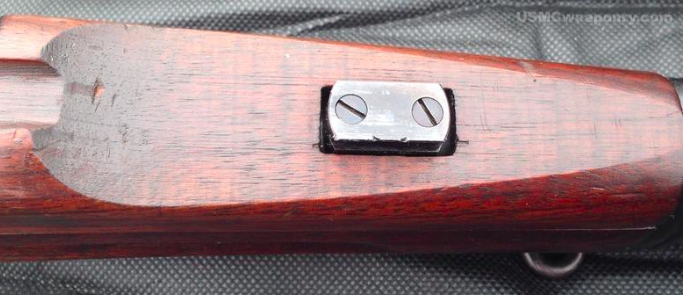
An interesting attribute that a minority of Special Target Unertl sniper rifles have is the presence of the colloquially termed “Philly Star,” a five pointed star on the top of the barrel near the front barrel band. The meaning of the Philly Star has yet to be explained in documentation, and while it has been given this name out of a long-held assumption it was applied by Marine armorers at the Philadelphia Depot, it is just as likely to have been applied elsewhere for a myriad of reasons. No original Unertl sniper rifles have been found with this marking, only some of the Special Target varieties have it present. What is certain is that it has been found on a very peculiar type of rifle that appears to have been assembled after the M1903 was replaced as the standard issue service rifle with the M1 Garand. These rifles, some sort of variant of the Special Target, are often found with serial numbers in the same dense groupings as Unertl sniper rifles, indicating they likely were once USMC National Match rifles. Some of these Special Target rifles have been drilled and tapped for Unertl blocks, and most have 1942 dated barrels with vise marks and Philly Star applied. Their bolts are usually WWII replacement types, and while blackened are polished where the electro-penciled serial number has been applied, the stocks and handguards of these rifles are usually numbered to the rifle as well. Of the 1047 National Match and Special Target rifles set aside for the Unertl sniper rifle program, at most roughly half were to be fully converted and sent to the Fleet Marine Force. As of now, the best guess is these interesting rifles needed new barrels or other work, and were in the process of being made into Unertl sniper rifles when the program was curtailed and the war ended. It seems that these Special Target rifles were instead built up for unknown purposes, perhaps for base recreational shooting clubs, which were very popular after WWII ended, or lower level matches until a sufficient supply of National Match M1 Garands were available. While documentation may or may not be found which would allow us to solve this mystery, their presence of Marine Corps rebuild traits, and proximity to confirmed Unertl sniper rifles presents strong evidence of their likely National Match origins. While we can’t yet be certain on the specifics of these rifles, it does seem safe to say that as of now there is no evidence the Philly Star had any relevance to the Unertl sniper program.
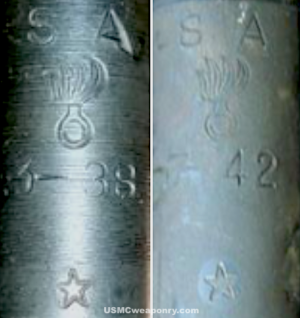
Comparison of a Special Target Unertl sniper with 5 -point stark marking on the barrel, and a Special Target variant assembled later: the barrel on the left is on USMC M1903A1 Unertl sniper rifle #1496175, the barrel on the right is on a Special Target rifle that was never converted into a Unertl sniper rifle. The meaning of the 5-point star, commonly referred to as the “Philly Star” is unknown at this time (Andrew Stolinski collection).
Unertl sniper rifles #1268778 and #1496175, both have Philly Star marked barrels (Andrew Stolinski & Georg Oberaigner collections).

An interesting rifle best referred to as a Special Target variety, a noteworthy amount of M1903s have surfaced in dense USMC National Match serial range clusters and with many USMC traits. As of now, it is best posited they were assembled later from rifles that were in the process of being converted to Unertl sniper rifles, but needed some level of rebuild first (Steven Norton collection).
While the attributes of these Special Target variety rifles are often similar, there are some variances. For example, this rifle, which bears a very early serial number, has had the receiver drilled and tapped for Unertl scope blocks. While most rifles like it have a Philly Star stamped into the barrel, this one has not. The presence of an army rebuild stamp on the stock is also interesting, and research is ongoing as to a potential army connection.
Another costly victim of popular misconception, some Special Target turned Unertl sniper rifles have been observed with fake star gauge markings on their muzzle. As with blued bolts that had their finished removed, it was previously thought all Unertl sniper rifles had star gauged barrels, and thus a misguided desire to “correct” these rifles to what used to be considered the right appearance has left some genuine examples permanently disfigured. While really needless to say, documents are constantly being discovered that are enhancing our understanding of the firearms of yesteryear. Permanent alterations to a rifle in an attempt to make them better fit a contemporary opinion can prove to be a painful mistake that can’t be taken back.
Examples of Unertl sniper rifles with star gauged barrels, from left to right serial numbers 1498646, 1496440, and 1464269 (Neil Duffy, Steven Norton, & Tim Plowman collections).
The process of converting the National Match and Special Target rifles into Unertl sniper rifles would take six weeks, beginning in January, 1943 with the first rifles shipping out to the 1st and 2nd Marine Divisions in February. The first shipment would initially be 150 rifles, later increased to 250. Arriving at the First Base Depot in the South Pacific not long after, these rifles would be sent to two very different situations for their combat debut. The 1st Marine Division would be slugging it out through the jungles of New Georgia, while the 2nd Marine Division would be tasked with assaulting the heavily defended Tarawa Atoll that November. The approach to sniping and the training of snipers themselves was also night and day different between the two units. The 1st Marine Division and the Marine Raiders would simply hand the weapons out to the better marksmen in their ranks, while the 2nd Marine Division had set up a sniper training program in New Zealand. Not surprisingly, the dense, sopping wet jungle campaign the 1st Marine Division encountered led to a poor report for the Unertl sniper rifle. The long range advantage afforded to Marine marksmen carrying the Unertl sniper rifle would prove to be a moot point in a jungle environment that saw most engagements taking place at close range. Furthermore, the more rugged Remington M1903A4 sniper rifle, which the 1st Marine Division had received after Guadalcanal when they were resupplied by the army proved to be a better fit at eliminating concealed but relatively close enemy snipers. The combat on Tarawa was not much more suited to employing the Unertl sniper rifle, due to the quick and chaotic nature of the battle. However, sniper platoons were effective at eliminating Japanese snipers and enemy positions during the three day battle.
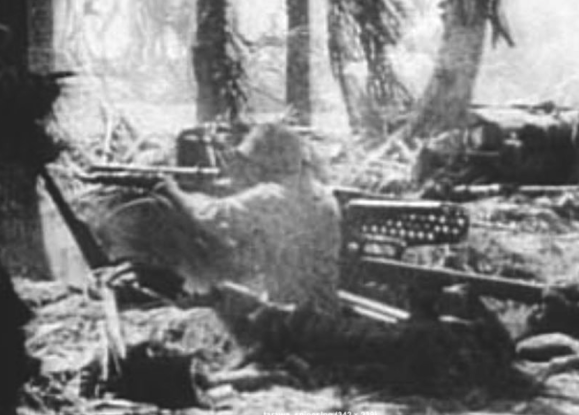 Marine Scout Sniper in action on Tarawa (still: USMC).
Marine Scout Sniper in action on Tarawa (still: USMC).

After the exhaustive combat on Guadalcanal, and owing to an extremely precarious logistical situation, the 1st Marine Division would be resupplied by the army instead of the standard Marine Corps supply system during their stay in Australia. This allowed the “Old Breed” Division to receive a compliment of Remington M1903A4 sniper rifles, equipped with a solid base and 2.5x Weaver scope (Steven Norton collection).
Rugged and durable, the low power M1903A4 performed excellently in the dense jungles of Cape Gloucester, and is pictured in the hands of 1st Marine Division marksmen above. The close quarters nature of the conflict is demonstrated in the lower left photo, with a Marine having fixed a bayonet to his M1903A4 in particularly thick vegetation (photos: USMC).
Documents detailing the early days of Unertl sniper rifle procurement (documents: NARA).
In order to better aid the two divisions already deployed, and to outfit the 3rd and 4th Marine Divisions as they were being stood up for combat, qualified Marines would be sent to Camp Elliot in California for sniper school. Here Marines ranging from privates to lieutenants would be trained in the arts of the scout/sniper, using both the Unertl sniper rifle and the Mann Niedner A5 sniper rifle from World War One. These new school trained Marine snipers would rejoin their units, or be sent to replacement battalions and given orders to the various divisions they would serve with in combat. The way Marine snipers would be employed varied dramatically from division to division. the 2nd and 4th Marine Divisions would have scout sniper platoons with official tables of organization, while the 1st Marine Division would simply divvy up their sniper rifles amongst their rifle platoons. The 3rd Marine Division would be somewhere in the middle of the two, with varying degrees of organization between regiments.
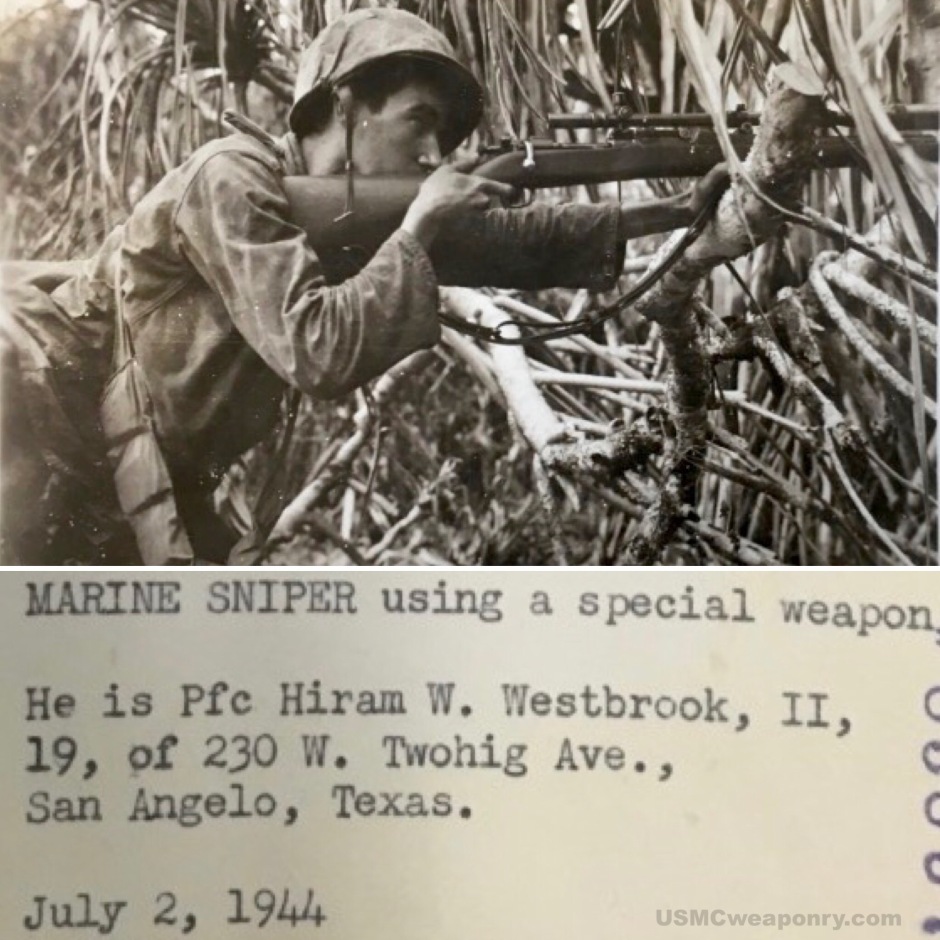
According to operational inventory, most divisions would employ between thirty and eighty sniper rifles. From here, the waters are a bit muddied for several reasons. Eighty of the earlier A5/5A M1903 sniper rifles had been put together in 1941, with the Marine Raiders receiving forty of them, the 5th Marine Regiment receiving twenty, and the others assumed to have been assigned to training commands or various small batch assignments to other units. Herein lies the problem, as hard counts performed by various units lumped both the A5/5A and Unertl sniper rifles together. A good example of this is with the 4th Marine Division. This particular division would heartily support utilizing scout/snipers, and would create a divisional table of organization and equipment as to who in the division would rate the Unertl sniper rifle. The 4th Marines requested to have their full compliment of the Unertl sniper rifles assigned to them before they left the states, and while it is unclear if this took place in time or they drew them from the 250 that had already been sent to the South Pacific, there is no mention of them ever receiving the earlier A5/5A rifles. This makes even more interesting an entry by the division talking about the use of Lyman 5A sniper rifles during the fighting on Roi-Namur, as they are listed as expended in combat. The meaning of this document is debatable, as photographs from that battle show 4th Marine Division snipers using Unertl sniper rifles, and the aforementioned improper use of sniper rifle nomenclature would plague the Marine Corps for the entirety of WWII, until it was addressed by the Commandant. On top of this, only Lyman 5A scopes are listed as having been expended in combat, with no mention of Unertls having met the same fate. It is highly unlikely that none of the division’s 68 Unertl scopes were lost in the fighting while 12 Lyman 5A’s were. Nonetheless, the document shows the muddled logistical situation the Marine Corps faced due to the lack of a service-wide standardization of sniper rifles.
Examples of the well recognized problem of sniper rifle nomenclature in official USMC reports (docs: NARA).
Ordnance reports from various Marine units detailing the quantity of their sniper rifles in WWII (docs: USMC & NARA).
USMC M1903A1 Unertl Sniper Rifle #1496440 (Tim Plowman collection).
USMC M1903 Unertl Sniper Rifle #1459600 (Steven Norton collection).
The two types of Unertl Sniper rifles: #1496440 is an original National Match rifle that was delivered to the Marines in 1937, it would have been one of the 359 rifles collected from the active duty rifle team, or one of the 104 collected from the reserve rifle team. #1459600 is a Special Target variant, and would have been one of the 574 that were collected from division or post teams. Straight stocked and C-stocked variants were both used by Marine snipers in the South Pacific during WWII.
Maintenance on Unertl sniper rifles was time intensive. The blued scope was prone to rusting, and the scope mounts were prone to coming loose. Coupled with the standard barrel maintenance demanded by corrosive ammunition and the South Pacific humidity, and it didn’t take long for those assigned a Unertl sniper rifle to become well versed in their upkeep (photos: USMC).
The 5th and 6th Marine Divisions would also have smaller amounts of sniper rifles, and according to several accounts were a mixed bag of Unertl and A5/5A types. While it is once again plausible this is due to the poor nomenclature differentiation that plagued WWII ordnance reports, the 5th and 6th Marine Divisions were comprised of former Marine Raider units, which indeed had been issued A5/5A sniper rifles early in the war. The Marine Raiders had been the first to receive the Unertl sniper rifle, and the extremely close and damp nature of the combat they faced on Bougainville and Cape Gloucester led to their disapproval of the design in general. As mentioned previously, the 1st Marine Division had found success with their army issued M1903A4 sniper rifles, a sturdy design that was much more suited for the dense jungle warfare the Corps faced in 1943. As such, the reports that reached higher headquarters from the 1st Marine Division and the Marine Raiders called for the abandonment of the Unertl sniper rifle, and procurement of the M1903A4 from the army. However, an entirely different experience was to be had in the following year, as 1944 would prove a great success for the Unertl sniper rifle. The Raiders would be disbanded that February, and thus never be able to organizationally utilize the Unertl sniper rifle in a more suitable environment, but the 2nd, 3rd, and 4th Marine Divisions would to good effect. These particular divisions would have excellent sniper organizations within their ranks, and the combat on Roi-Namur, Saipan, Tinian, and Guam saw the conditions to be quite favorable for the proper employment of the Unertl sniper rifle. As these reports overwhelmingly drowned out those of the Unertl sniper rifle’s performance the soggy jungles of 1943, it became clear to the Marine higher command that a Fleet Marine Force level decision must be made. The army had become deeply invested in the success of an M1 Garand sniper rifle, known as the M1C and later the M1D. Both of these programs struggled to prove of great benefit in regards to accuracy, chiefly due to design flaws and the limitations of the off-center mounted scope, tamping down Marine enthusiasm in the Garand sniper. Following combat on Iwo Jima and Okinawa where the Unertl sniper rifle was well praised, the Marine Corps finally decided to officially adopt the Unertl sniper rifle with a quota of 108 rifles per division. However, not long after the order was issued WWII would come to an end. It is nearly certain that this quota was not fulfilled for the six Marine divisions, as the 1st and 2nd Marine Divisions would be the only ones to exist following post-war downsizing.
Documents detailing the higher Marine Corps debate on the validity of the Unertl sniper rifle and Marine sniper program in general in 1944-45 (docs: NARA).
Though a very accurate rifle, the Winchester Model 70 would not be utilized as a sniper rifle by the Marine Corps in WWII. The several hundred M70s procured by the Marine Corps in 1941-1942 would ultimately be sold off at post exchanges (docs: NARA).
With standard ball ammo the M1903A1 Unertl Sniper Rifle was expected to hold 1.5 minutes-of-angle, or roughly 1.5 inches at 100 yards, doubling in diameter every 100 yards farther in distance (Tim Plowman collection).
Marine Snipers in action on Okinawa. These photos are noteworthy as they show Unertl sniper rifles of the straight stocked variety in action, the only such photos that exist as of now (photos: NARA & USMC).
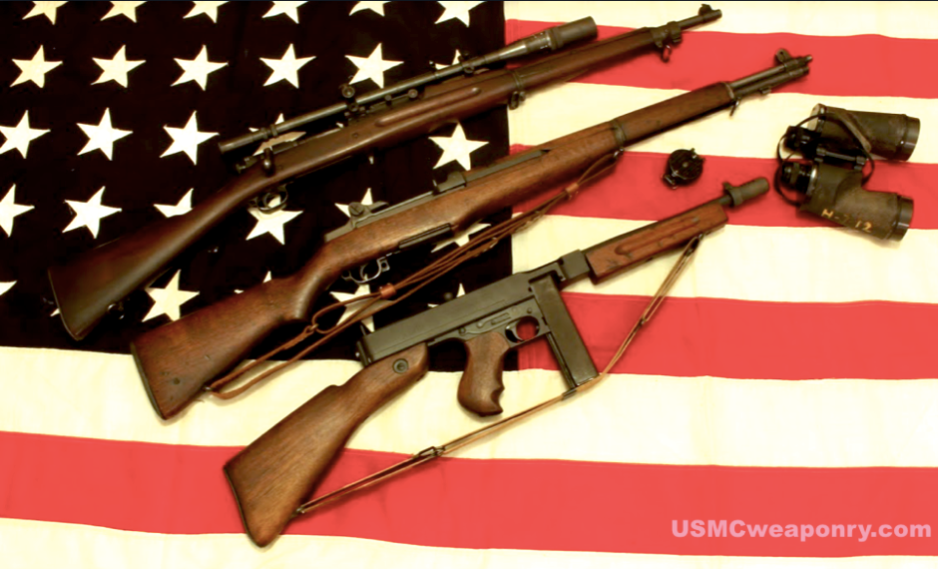
USMC M1903 Unertl Sniper Rifle #1464269, with the standard weapons that would accompany a Marine sniper team in the South Pacific (Neil Duffy collection).
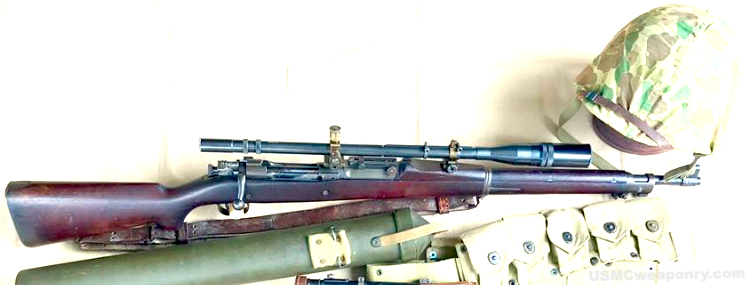
USMC M1903A1 Sniper Rifle #1497141 (Matt Darnall collection).
When the Korean War broke out, the Marines were once again in an uncertain spot in regards to sniper rifles, and sniping in general. There were ample M1903A1 Unertl sniper rifles to draw from, as well as a small compliment of M1C Garand sniper rifles, but the men to whom they were issued varied widely. The massive downsizing after WWII left just the 1st and 2nd Marine Divisions still active, with the 1st Marine Division being the only one tasked with the fighting in Korea. As was 1st Marine Division policy in WWII, sniper rifles were distributed throughout the ranks at the discretion of the small unit commander, preferably to those that were already keen marksmen. While little is recorded about 1st Marine Division snipers in WWII, much is readily found for the “Old Breed” Division’s snipers in Korea. As was the case in the prior war, contention and a mixed bag of results on sniper employment, training, equipment, and the need for snipers themselves would continue up until the end of hostilities.
Marine snipers with their M1903A1 Unertl sniper rifles in action in Korea (photos: USMC).
Documents in regards to the 1st Marine Division’s sniper program in Korea (documents: NARA).
Luckily, many photos of Unertl sniper rifles during the Korean War have been identified. One interesting note is the absence of straight stocked Unertl sniper rifles in any Korean War photos that have surfaced thus far. The reasons behind this are unknown, and could be as simple as the fact that most of the 1047 rifles set aside for conversion would indeed have been in C stocks due to the Marine rifle teams having adopted them in 1929. While WWII Unertl sniper rifle photos are relatively scarce, two straight stocked examples are seen next to each other on Okinawa, which asks the question as to whether they were field replacements or original. While a handful of genuine Unertl sniper rifles have been found in straight stocks, as of now only one has been found in it’s original straight stock from its days with the rifle teams. It is also possible that the Unertl sniper rifles used by the 1st Marine Division in Korea were specifically selected from existing stores, with only those in C stocks being utilized. Documents indicate roughly 200 M1903A1 Unertl sniper rifles were available during the Korean War, more than enough to fulfill specific requests by the division.
The terrain in Korea made for excellent long distance sniping opportunities (photos: USMC).
As indicated by archival documentation, despite a disadvantage in range and accuracy, the Marines were considering replacing the M1903A1 Unertl sniper rifle with the M1C early into the conflict. For the same reason that led to the Marines adopting the M1903 over the Winchester M70 early in WWII, the M1C was now more advantageous due to the availably of parts from the Marine Corps’ standard service rifle, the M1 Garand. Eventually, it would lead to the Marines adopting the Kollmorgen MC-1 scope and a new mount for the M1C, for a total package that would be referred to as the “M1952 sniper rifle.” The M1952 sniper rifle program would not come to fruition in time to see action in Korea, bout would be sufficient enough for the M1903A1 Unertl sniper rifles to be relegated obsolete in the mid 1950s. From there, the M1903A1 Unertl sniper rifles would have their scopes removed and be sent to morale and welfare clubs throughout the Corps, making for excellent sporting use recreationally. The Unertl 8x scopes that had been on the M1903A1s through WWII and Korea were now mounted on the same Winchester M70s the Marines had decided not to use twenty years prior, and in this form would see the evolution of a permanent, professional cadre of Scout/Snipers be born during the Vietnam War.
Marine snipers often worked in tandem in Korea, one armed with a M1903A1 Unertl sniper rifle, the other an M1C Garand sniper rifle (photo: USMC).
It is likely that during the base recreational club phase of the M1903A1 Unertl sniper rifle’s history some were sporterized to varying levels. A handful of genuine rifles have been found drilled and tapped for Redfield bases, others have been found with various sporterizations to stocks and handguards. Some have been found in stocks that while military in nature would not have been available when they left the Philadelphia Depot, as well as befitted with various M1903A3 parts. Of course all of these things could have been done post service, but the similarities between the work seem to hint at it being done while in Marine custody. As noted by several genuine examples, the M1903A1 Unertl sniper rifles were eventually sold to Marines interested in buying them. This is the reason as to why a noteworthy amount of Unertl sniper rifles have been found in existence today, and a fortunate one at that, as they very easily could’ve been destroyed in the 1990s during government obsolete arms reduction programs.
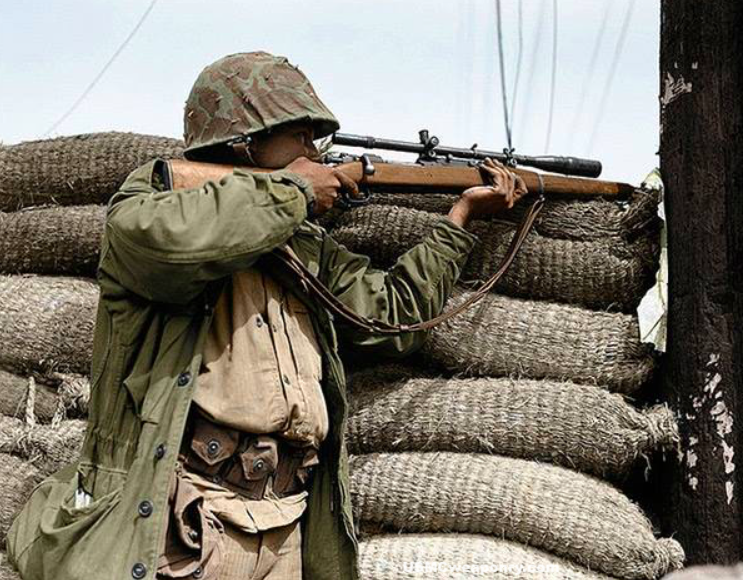
Page acknowledgments:
A special thanks to Steven Norton for his tireless work on the subject of USMC sniper rifles of the World Wars.


